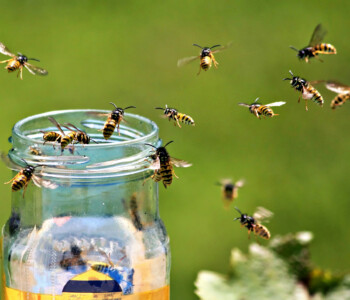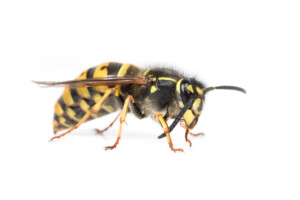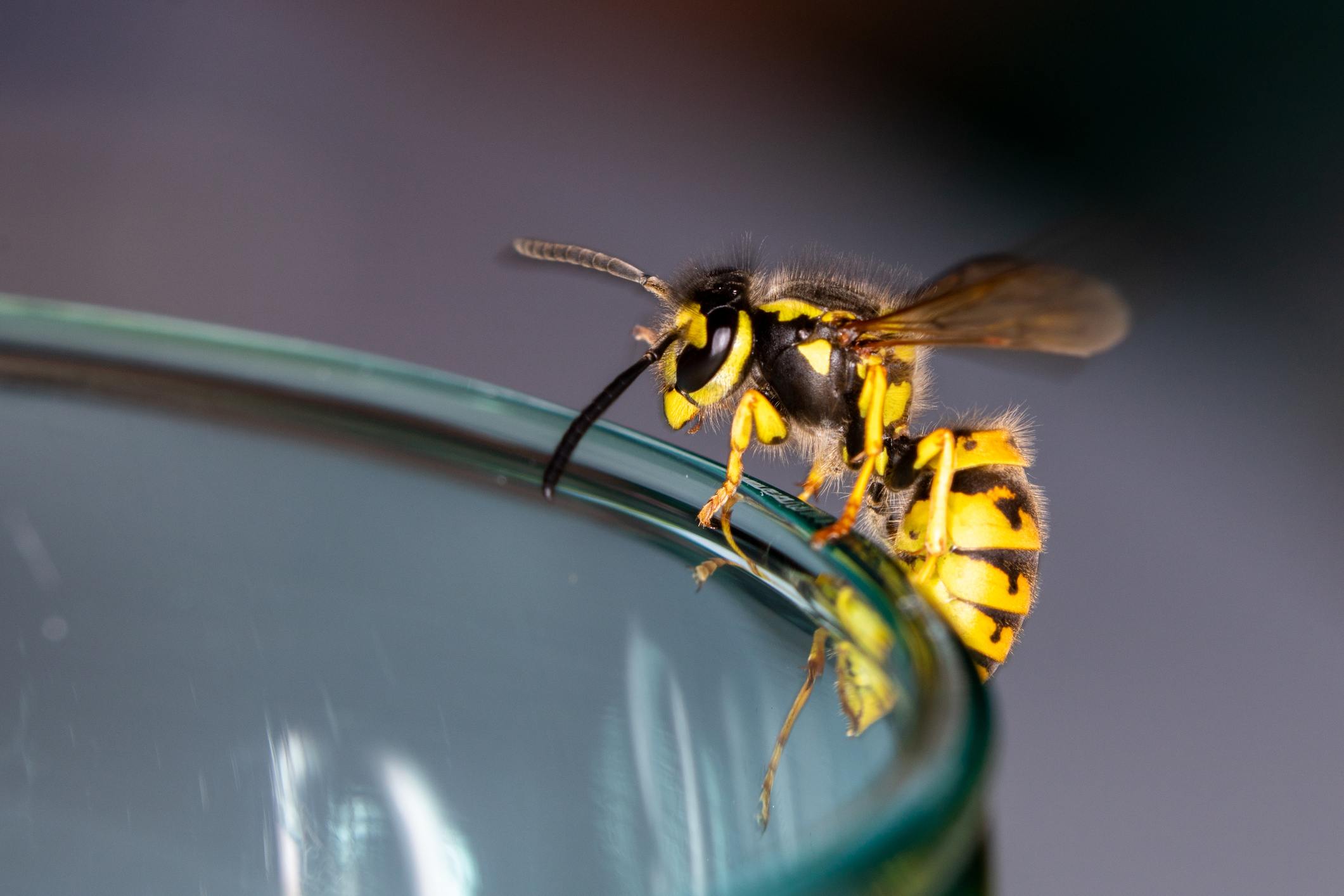Wasps are common stinging insects that play a significant role in the environment, helping control pest populations by preying on other insects. However, when they build nests around homes and recreational areas, they can become a hazard due to their painful stings and aggressive behavior.
WASPS IN WISCONSIN
Wisconsin is home to a variety of wasp species, ranging from social wasps like yellowjackets to solitary wasps such as mud daubers. While most wasps are beneficial to the ecosystem, some can become a nuisance or a danger to humans, especially in the late summer and fall when their colonies are fully established.
WHAT DO WASPS LOOK LIKE?
Wasps are often confused with bees due to their similar size and color patterns, but they can be distinguished by their slender bodies and smooth appearance. Here’s how to identify them:
- Body Shape: Wasps have a narrow, defined waist (known as the petiole) that separates their abdomen and thorax, unlike the rounder bodies of honey bees or bumblebees.
- Size: Wasps vary in size depending on the species, but most range between 0.5 to 1 inch in length. Some species, like the Northern giant hornet (Vespa mandarinia), can grow over 2 inches.
- Color: Wasps tend to have bright, contrasting colors, often in yellow and black patterns. Yellowjackets, for instance, are famous for their striking yellow and black stripes, while paper wasps (Polistes) are generally brown with some yellow markings.
- Wings: Wasps have two pairs of smooth, translucent wings, with the forewings being larger than the hind wings. Their wings are folded lengthwise when at rest, a key feature distinguishing them from bees.
- Stinger: Only female wasps have stingers, which they use both to paralyze prey and to defend their nests. Unlike the majority of bees, most wasps can sting multiple times without losing their stinger.
DO I HAVE A WASP INFESTATION?
A wasp infestation is typically easy to recognize, particularly in late summer when colonies are at their largest. Signs that you may have a wasp problem include increased numbers of wasps, discovering a nest or noting an increase in aggressive wasp behavior. Wasps become more aggressive as summer progresses, especially near their nests. If wasps begin flying towards you or displaying defensive behavior, it may indicate a nest close by.
Increased numbers of wasps flying around your home, garden, or yard can be a sign that a nest is nearby. The paper-like wasp nests can be found under eaves, in wall voids, attics, trees, or sheds. Social wasps, like yellowjackets and paper wasps, construct nests using chewed wood fibers mixed with saliva, creating a papery structure. Nests can vary in size from a small handful to basketball-sized structures.
HABITAT, DIET, LIFE CYCLE & BEHAVIORS
Understanding where wasps live, what they eat, and how they behave can help in managing or preventing infestations around your property.
WHERE DO WASPS LIVE?
Wasps are versatile and can live in a wide range of environments. Their habitat choices depend on the species:
- Social Wasps: Species like yellowjackets and paper wasps build their nests in protected areas such as eaves, attics, tree branches, wall voids, or underground burrows. These colonies can grow large, with hundreds of worker wasps by late summer.
- Solitary Wasps: Species like mud daubers and cuckoo wasps (Chrysididae) tend to be solitary and do not build large nests. They often create their homes in pre-existing cavities, such as in wood, hollow reeds, or man-made structures.
- European hornets prefer hollow trees or similar sheltered areas, while fig wasps are typically found around fig trees, where they have a specialized pollination relationship.
DIET
Wasps have a diverse diet that changes throughout their life cycle. Adult wasps primarily consume nectar, fruit, and sugary liquids. By late summer, worker wasps seek out sweet foods more aggressively, which is why they are often seen hovering around soda cans, fruit, or other sugary items. Some wasps are also carnivorous, feeding on other insects such as flies, caterpillars, and spiders. Paper wasps and yellowjackets, for example, are crucial in controlling pest populations, as they hunt insects to feed their larvae. And parasitic wasps lay their eggs in or on other insects; the larvae then feed on the host, providing an essential form of natural pest control.
LIFE CYCLE
Wasps progress through four stages: egg, larva, pupa, and adult. The queen lays eggs in individual cells within the nest. For social wasps, this process begins in the spring when the queen establishes a new colony. After hatching, the larvae are fed by worker wasps (in social species) or by provisions left by the mother (in solitary species). The larvae develop rapidly and once fully grown enter the pupa stage, spinning a silken cap over their cell. During this stage, they develop into adult wasps. Adult worker wasps emerge and take over nest maintenance, foraging, and caring for the queen’s future offspring. In late summer, the queen produces males and new queens to ensure the continuation of the species.
BEHAVIORS
Social wasps are highly protective of their nests. They will sting multiple times if they feel their colony is under threat, and their aggressive nature increases as the colony grows. Wasps also become more aggressive as the colony matures and food becomes scarce towards the end of summer.
As active foragers, wasps hunt other insects and scavenge for sugary substances, particularly as the summer season draws to an end.
ARE WASPS DANGEROUS?
Wasps can be dangerous, especially if you are allergic to their stings. Some wasp species are more aggressive than others. For instance, yellowjackets and bald-faced hornets are known for their hostile behavior, while paper wasps tend to be less aggressive unless their nest is directly threatened. The severity of a wasp sting varies depending on the individual and the species of wasp.
Painful Stings: Wasp stings are known to be particularly painful due to the venom they inject. Some species, like yellowjackets, are more aggressive and sting with little provocation.
Multiple Stings: Unlike honey bees, which lose their stinger after one use, wasps can sting multiple times. This makes them more dangerous if they feel threatened or if their nest is disturbed.
Allergic Reactions: For people allergic to wasp venom, stings can cause severe reactions, including anaphylaxis, which can be life-threatening. If you or someone else experiences difficulty breathing, swelling, or hives after a wasp sting, seek emergency medical attention immediately.
Aggressive Species: Some wasp species are more aggressive than others. For instance, yellowjackets and bald-faced hornets are known for their hostile behavior, while paper wasps tend to be less aggressive unless their nest is directly threatened.
HOW TO GET RID OF WASPS?
Getting rid of wasps can be challenging, especially if a colony has taken up residence near your home. If you notice a large wasp nest or aggressive wasps, it’s best to contact a professional residential pest control company, like Terminix Wil-Kil, who have the proper equipment and insecticides to safely remove nests without putting you at risk.
For smaller nests, some homeowners may choose to use insecticidal sprays designed for wasps. These sprays should be applied in the evening or early morning when the wasps are less active. Always wear protective clothing and stand at a safe distance to avoid stings.
Another option is wasp traps baited with sweet substances, which can help reduce wasp populations around your home, although they are not a solution for eliminating nests.
HOW TO PREVENT WASPS
Preventing wasps from nesting around your property is the best way to avoid stings and infestations. Here are some practical prevention tips:
- Seal Entry Points: If wasps are entering your home through cracks or holes, sealing these entry points can prevent them from nesting inside walls or attics.
- Remove Food Sources: Wasps are attracted to sweet foods and garbage. Ensure that outdoor trash bins are tightly sealed, and avoid leaving food or sugary drinks outside.
- Eliminate Standing Water: Wasps, like many insects, are drawn to water sources. Remove or reduce standing water around your home to make it less appealing to them.
- Plant Wasp-Repelling Herbs: Certain herbs, such as mint and eucalyptus, are known to repel wasps. Planting these around your home may help keep wasps at bay.
NEED HELP WITH STINGING INSECT CONTROL IN YOUR WISCONSIN HOME?
Wasps are not only a nuisance; they can pose a serious threat if they feel their colony is in danger. If you’re dealing with wasps around your home, it’s essential to take quick and effective action. Professional stinging insect control services can protect your home from wasps. By addressing wasp nests early and implementing preventive measures, you can avoid the discomfort and dangers associated with these aggressive insects.
FAQS
DO WASPS STING OR BITE?
Wasps can sting but do not typically bite humans. Their sting is their primary defense mechanism, and it can be very painful due to the venom injected.
HOW LONG DO WASPS LIVE?
Most worker wasps live for a few weeks, while queens can live for up to a year, hibernating through the winter and re-emerging in the spring to start new colonies.
ARE PAPER WASPS AGGRESSIVE?
Paper wasps are generally less aggressive than other wasp species, but they will defend their nests if threatened.
DO WASPS DIE AFTER THEY STING?
No, unlike honey bees, wasps do not die after stinging. They can sting multiple times, making them more dangerous when defending their nest.
DO WASPS HIBERNATE?
Only queen wasps hibernate during the winter. They emerge in the spring to establish new colonies.
Related Posts From Our Blog
How to Get Rid of Wasps in the Winter
Spotting a wasp around your home can be alarming, especially during the winter season. Running across a wasp can also be an indication of more in the area. Some wasps survive the colder months by [...]
When Wasps Attack: Signs of a Wasp Infestation and How to Prevent One
Wasps are among the most intimidating stinging insects to encounter. While many bees can only sting you once, wasps can sting multiple times. Stings are painful, and can even trigger an allergic reaction. When you [...]
Bite- and Sting-Free Celebrations
For many of us, the outdoors has become an escape from day-to-day life as we try to find a new normal with COVID-19. Warm weather combined with the need for social distancing also means that [...]
Wasp Facts & Identification in Sun Prairie, WI
Terminix Wil-Kil Pest Control is a local Pest Control and Extermination company helping homeowners and businesses with pest issues across WI.





